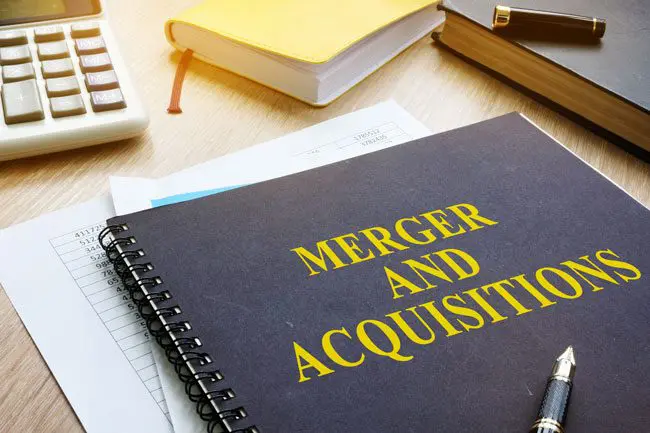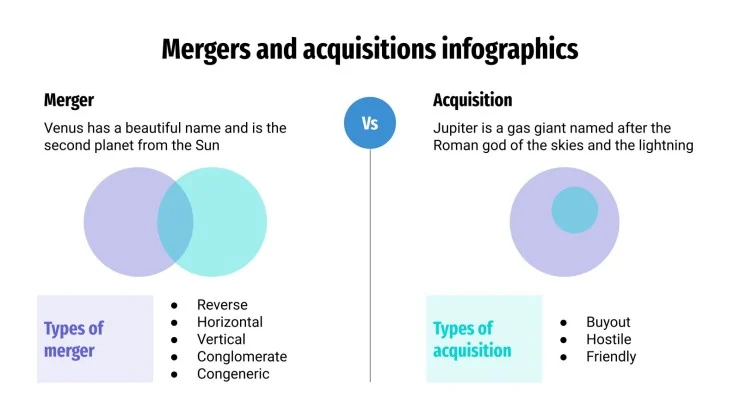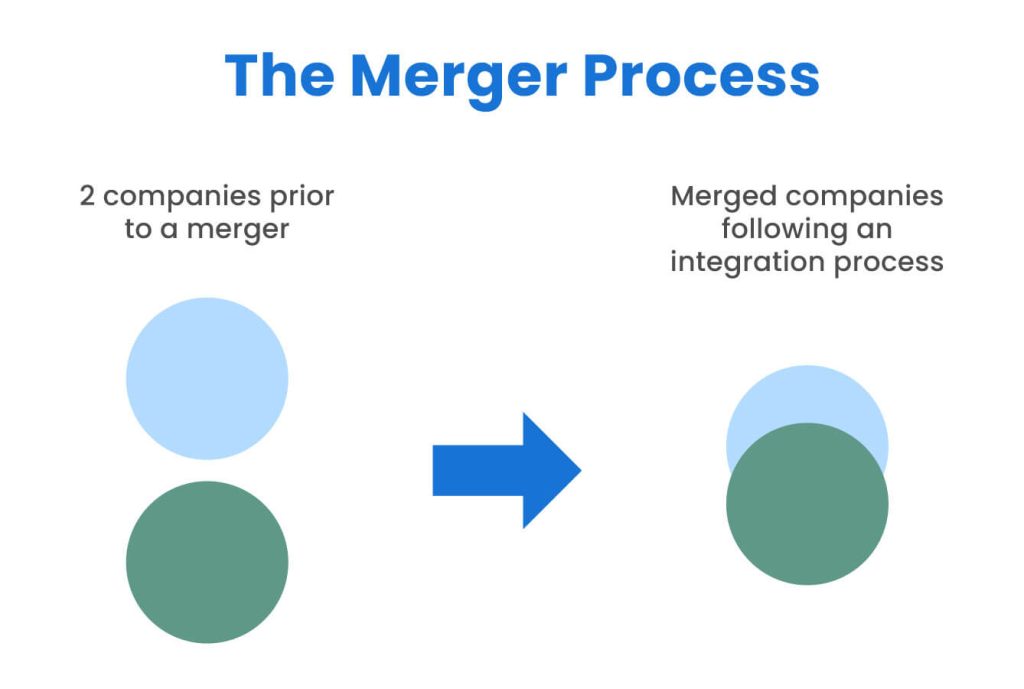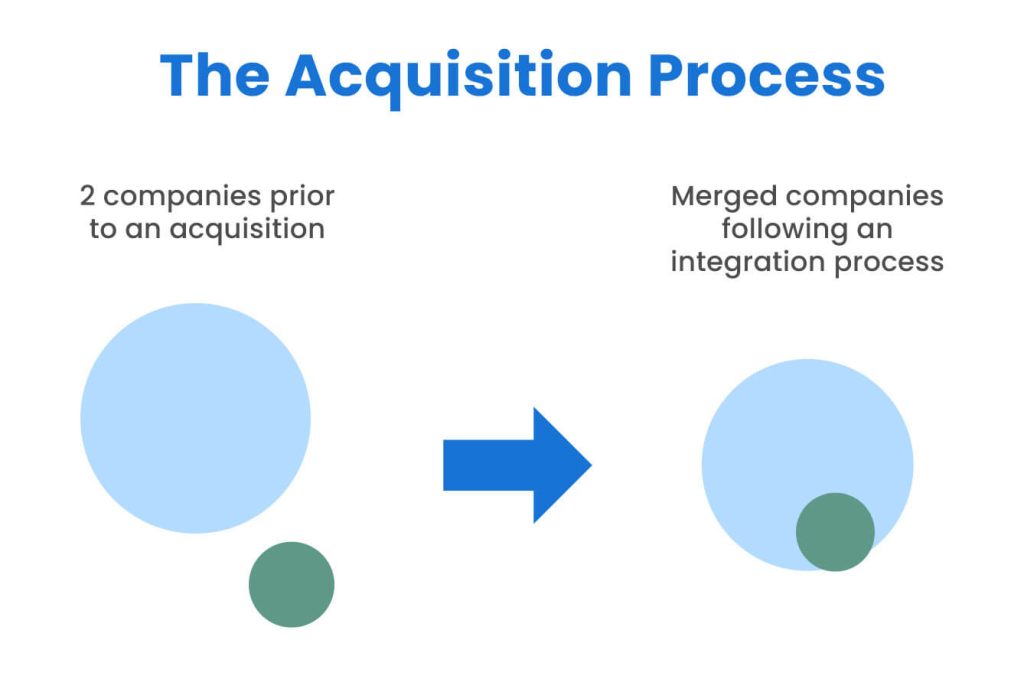
What Are Mergers and Acquisitions (M&A)?
The term mergers and acquisitions (M&A) refers to the consolidation of companies or their major business assets through financial transactions between companies. A company may purchase and absorb another company outright, merge with it to create a new company, acquire some or all of its major assets, make a tender offer for its stock, or stage a hostile takeover.
The term M&A also is used to describe the divisions of financial institutions that deal in such activity.
KEY TAKEAWAYS
- The terms “mergers” and “acquisitions” are often used interchangeably, but they differ in meaning.
- In an acquisition, one company purchases another outright.
- A merger is the combination of two firms, which subsequently form a new legal entity under the banner of one corporate name.
- A company can be objectively valued by studying comparable companies in an industry and using metrics.
Understanding Mergers and Acquisitions
The terms mergers and acquisitions are often used interchangeably, however, they have slightly different meanings.
When one company takes over another and establishes itself as the new owner, the purchase is called an acquisition.
On the other hand, a merger describes two firms, of approximately the same size, that join forces to move forward as a single new entity, rather than remain separately owned and operated. This action is known as a merger of equals.
A purchase deal will also be called a merger when both CEOs agree that joining together is in the best interest of both of their companies.
Unfriendly or hostile takeover deals, in which target companies do not wish to be purchased, are always regarded as acquisitions. A deal can be classified as a merger or an acquisition based on whether the acquisition is friendly or hostile and how it is announced. In other words, the difference lies in how the deal is communicated to the target company’s board of directors, employees, and shareholders.
Types of Mergers and Acquisitions

The following are some common transactions that fall under the M&A umbrella.
Mergers

In a merger, the boards of directors for two companies approve the combination and seek shareholders’ approval. For example, in 1998, a merger deal occurred between the Digital Equipment Corporation and Compaq, whereby Compaq absorbed the Digital Equipment Corporation.4 Compaq later merged with Hewlett-Packard in 2002.5 Compaq’s pre-merger ticker symbol was CPQ. This was combined with Hewlett-Packard’s ticker symbol (HWP) to create the current ticker symbol (HPQ).
Acquisitions

In a simple acquisition, the acquiring company obtains the majority stake in the acquired firm, which does not change its name or alter its organizational structure. The target company may require the buyers to promise that the target business remains solvent for a period after acquisition through the use of a whitewash resolution.
Consolidations
Consolidation creates a new company by combining core businesses and abandoning the old corporate structures. Stockholders of both companies must approve the consolidation, and subsequent to the approval, receive common equity shares in the new firm.
Tender Offers
In a tender offer, one company offers to purchase the outstanding stock of the other firm at a specific price rather than the market price. The acquiring company communicates the offer directly to the other company’s shareholders, bypassing the management and board of directors.
Acquisition of Assets
In an acquisition of assets, one company directly acquires the assets of another company. The company whose assets are being acquired must obtain approval from its shareholders. The purchase of assets is typical during bankruptcy proceedings, wherein other companies bid for various assets of the bankrupt company, which is liquidated upon the final transfer of assets to the acquiring firms.
Management Acquisitions
In a management acquisition, also known as a management-led buyout (MBO), a company’s executives purchase a controlling stake in another company, taking it private. These former executives often partner with a financier or former corporate officers in an effort to help fund a transaction. Such M&A transactions are typically financed disproportionately with debt, and the majority of shareholders must approve it.
How Mergers Are Structured
Mergers can be structured in a number of different ways, based on the relationship between the two companies involved in the deal:
- Horizontal merger: Two companies that are in direct competition and share the same product lines and markets.
- Vertical merger: A customer and company or a supplier and company. Think of an ice cream maker merging with a cone supplier.
- Congeneric mergers: Two businesses that serve the same consumer base in different ways, such as a TV manufacturer and a cable company.
- Market-extension merger: Two companies that sell the same products in different markets.
- Product-extension merger: Two companies selling different but related products in the same market.
- Conglomeration: Two companies that have no common business areas.
Mergers may also be distinguished by following two financing methods, each with its own ramifications for investors.
Purchase Mergers
As the name suggests, this kind of merger occurs when one company purchases another company. The purchase is made with cash or through the issue of some kind of debt instrument. The sale is taxable, which attracts the acquiring companies, who enjoy the tax benefits. Acquired assets can be written up to the actual purchase price, and the difference between the book value and the purchase price of the assets can depreciate annually, reducing taxes payable by the acquiring company.
Consolidation Mergers
With this merger, a brand new company is formed, and both companies are bought and combined under the new entity. The tax terms are the same as those of a purchase merger.
How Acquisitions Are Financed
A company can buy another company with cash, stock, assumption of debt, or a combination of some or all of the three. At times, the investment bank involved in the sell of one company might offer financing to the buying compnay. This is known as staple financing and is done to produce larger and timely bids.
In smaller deals, it is also common for one company to acquire all of another company’s assets. Company A buys all of Company B’s assets for cash, which means that Company B will have only cash (and debt, if any). Of course, Company B becomes merely a shell and will eventually liquidate or enter other areas of business.
Another acquisition deal known as a reverse merger enables a private company to become publicly listed in a relatively short time period. Reverse mergers occur when a private company that has strong prospects and is eager to acquire financing buys a publicly listed shell company with no legitimate business operations and limited assets. The private company reverses merges into the public company, and together they become an entirely new public corporation with tradable shares.
How Mergers and Acquisitions Are Valued
Both companies involved on either side of an M&A deal will value the target company differently. The seller will obviously value the company at the highest price possible, while the buyer will attempt to buy it for the lowest price possible. Fortunately, a company can be objectively valued by studying comparable companies in an industry, and by relying on the following metrics.
Price-to-Earnings Ratio (P/E Ratio)
With the use of a price-to-earnings ratio (P/E ratio), an acquiring company makes an offer that is a multiple of the earnings of the target company. Examining the P/E for all the stocks within the same industry group will give the acquiring company good guidance for what the target’s P/E multiple should be.
Enterprise-Value-to-Sales Ratio (EV/Sales)
With an enterprise-value-to-sales ratio (EV/sales), the acquiring company makes an offer as a multiple of the revenues while being aware of the price-to-sales (P/S ratio) of other companies in the industry.
Discounted Cash Flow (DCF)
A key valuation tool in M&A, a discounted cash flow (DFC) analysis determines a company’s current value, according to its estimated future cash flows. Forecasted free cash flows (net income + depreciation/amortization (capital expenditures) change in working capital) are discounted to a present value using the company’s weighted average cost of capital (WACC). Admittedly, DCF is tricky to get right, but few tools can rival this valuation method.
Replacement Cost
In a few cases, acquisitions are based on the cost of replacing the target company. For simplicity’s sake, suppose the value of a company is simply the sum of all its equipment and staffing costs. The acquiring company can literally order the target to sell at that price, or it will create a competitor for the same cost.
Naturally, it takes a long time to assemble good management, acquire property, and purchase the right equipment. This method of establishing a price certainly wouldn’t make much sense in a service industry wherein the key assets (people and ideas) are hard to value and develop.
How Do Mergers Differ From Acquisitions?
In general, “acquisition” describes a transaction, wherein one firm absorbs another firm via a takeover. The term “merger” is used when the purchasing and target companies mutually combine to form a completely new entity. Because each combination is a unique case with its own peculiarities and reasons for undertaking the transaction, the use of these terms tends to overlap.
Why Do Companies Keep Acquiring Other Companies Through M&A?
Two of the key drivers of capitalism are competition and growth. When a company faces competition, it must both cut costs and innovate at the same time. One solution is to acquire competitors so that they are no longer a threat. Companies also complete M&A to grow by acquiring new product lines, intellectual property, human capital, and customer bases. Companies may also look for synergies. By combining business activities, overall performance efficiency tends to increase, and across-the-board costs tend to drop as each company leverages the other company’s strengths.
What Is a Hostile Takeover?
Friendly acquisitions are most common and occur when the target firm agrees to be acquired; its board of directors and shareholders approve of the acquisition, and these combinations often work for the mutual benefit of the acquiring and target companies.
Unfriendly acquisitions, commonly known as hostile takeovers, occur when the target company does not consent to the acquisition.
Hostile acquisitions don’t have the same agreement from the target firm, and so the acquiring firm must actively purchase large stakes of the target company to gain a controlling interest, which forces the acquisition.
How Does M&A Activity Affect Shareholders?
Generally speaking, in the days leading up to a merger or acquisition, shareholders of the acquiring firm will see a temporary drop in share value. At the same time, shares in the target firm typically experience a rise in value. This is often due to the fact that the acquiring firm will need to spend capital to acquire the target firm at a premium to the pre-takeover share prices.
After a merger or acquisition officially takes effect, the stock price usually exceeds the value of each underlying company during its pre-takeover stage. In the absence of unfavorable economic conditions, shareholders of the merged company usually experience favorable long-term performance and dividends.
Note that the shareholders of both companies may experience a dilution of voting power due to the increased number of shares released during the merger process. This phenomenon is prominent in stock-for-stock mergers, when the new company offers its shares in exchange for shares in the target company, at an agreed-upon conversion rate. Shareholders of the acquiring company experience a marginal loss of voting power, while shareholders of a smaller target company may see a significant erosion of their voting powers in the relatively larger pool of stakeholders.
What Is the Difference Between a Vertical and Horizontal Merger or Acquisition?
Horizontal integration and vertical integration are competitive strategies that companies use to consolidate their position among competitors. Horizontal integration is the acquisition of a related business. A company that opts for horizontal integration will take over another company that operates at the same level of the value chain in an industry.
Vertical integration refers to the process of acquiring business operations within the same production vertical. A company that opts for vertical integration takes complete control over one or more stages in the production or distribution of a product.

